Many newsrooms are overwhelmed by the volume of decisions they face each day. User needs offer a way to bring clarity back into the process and guide coverage with intention.
-
Aliya Itzkowitz
Today, many newsrooms face constraints on their time and money. So, what if there were a way to do more, with less? A closer look at what readers read and why they read it reveals that publications often produce too much of the wrong type of content. Yet, it’s not just cash-strapped newsrooms that stand to benefit from re-examining content output. Readers are the other party that benefits.
This year’s Reuters News Report recently revealed that many audiences are suffering from ‘news fatigue.’ Against this backdrop, in a hyper-competitive attention economy, publications cannot afford to think they know what readers want. ‘User Needs’ provides a quick and easy way to test your assumptions, putting the reader at the centre of content strategy.
‘User Needs’ is a concept used and evangelised by former BBC journalist Dmitry Shishkin. Now an independent consultant and advisor, Dmitry spent over 20 years at the BBC, where he was responsible for implementing the ‘User Needs’ model across the BBC World Service Language teams from 2016. For those new to Dmitry’s work, I recommend reading his recent LinkedIn post: User needs in content publishing: the slide that started it all, five years later. The idea behind ‘User Needs’ is that readers consume news for reasons beyond simply staying informed.
At the BBC, Dmitry helped teams adopt the following six categories as part of their editorial strategies:
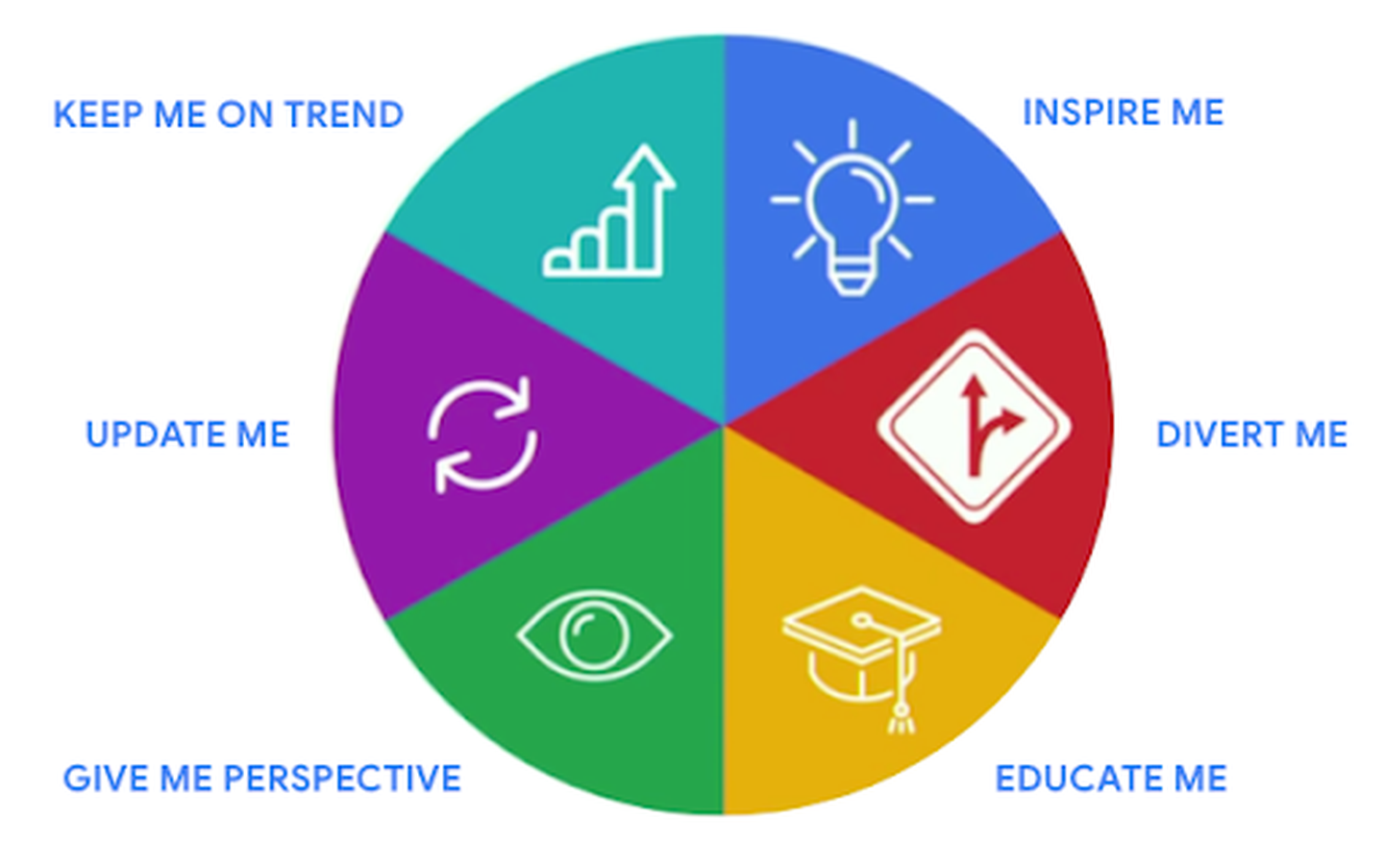




To bring this to life, let’s look at a worked example. Consider the war in Ukraine, told through each of these lenses.
The following are all real headlines:
Example 1: Update Me: a regular news story, what happened





Example 2: Give me Perspective: an analysis of how the event went, what it means





Example 3: Educate Me: tell me more about a subject or person in the story





Example 4: Divert Me: show me something lighter, less serious connected to the story





Example 5: Inspire Me: features someone who overcame odds, makes the reader proud





Example 6: Keep Me on Trend: what do people say about this event on social media





Sources: BBC, Politico, The New Yorker, The Guardian, Buffalo.edu, ANINews.in
Experimenting with content output and consumption by ‘user need’
To apply this concept, newsrooms must tag and track articles by ‘user needs’ categories to evaluate how their current editorial output aligns with what readers consume.
We recently ran this experiment with three publishers. The experiment was simple. A member of the editorial staff retroactively tagged articles to the agreed ‘user needs’ categories. This should be done for 2-3 months or until at least 1,000 articles are included so as to have statistical significance. We used data from 1-2 months due to time constraints.
We ran this experiment with three different publishers in the U.K. and found that, in all cases, there was a mismatch between content output and audience interest in different ‘user needs.’ All publishers over-indexed towards breaking news updates, despite other categories like ‘Educate me’ driving higher page views and time on site.
Publisher 1:
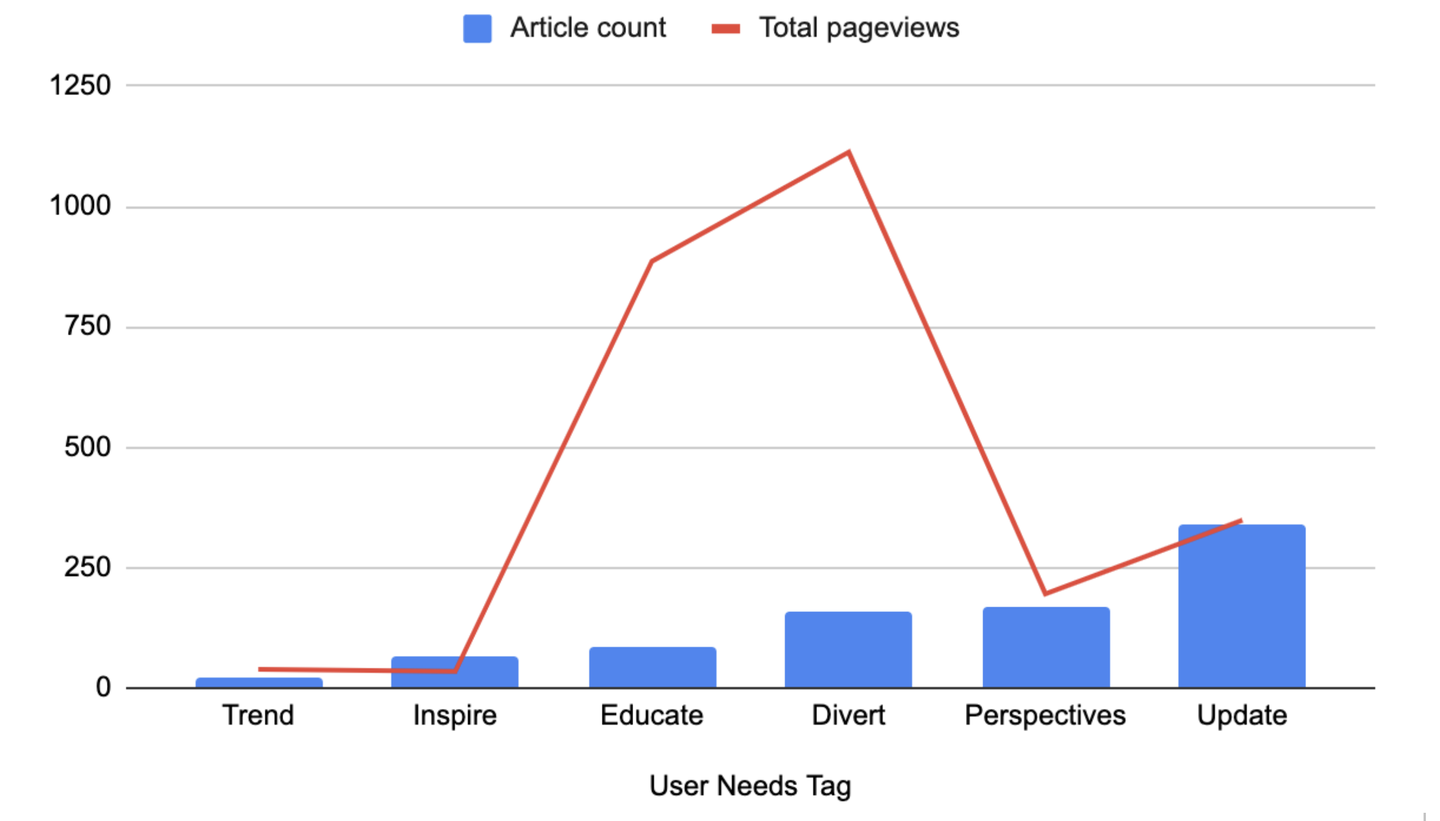




Publisher 1 found that 40% of articles produced were ‘Update me’ but this drove only 13% of page views. Meanwhile, 19% of articles were ‘Divert me’ but they drove 43% of page views
Publisher 2:
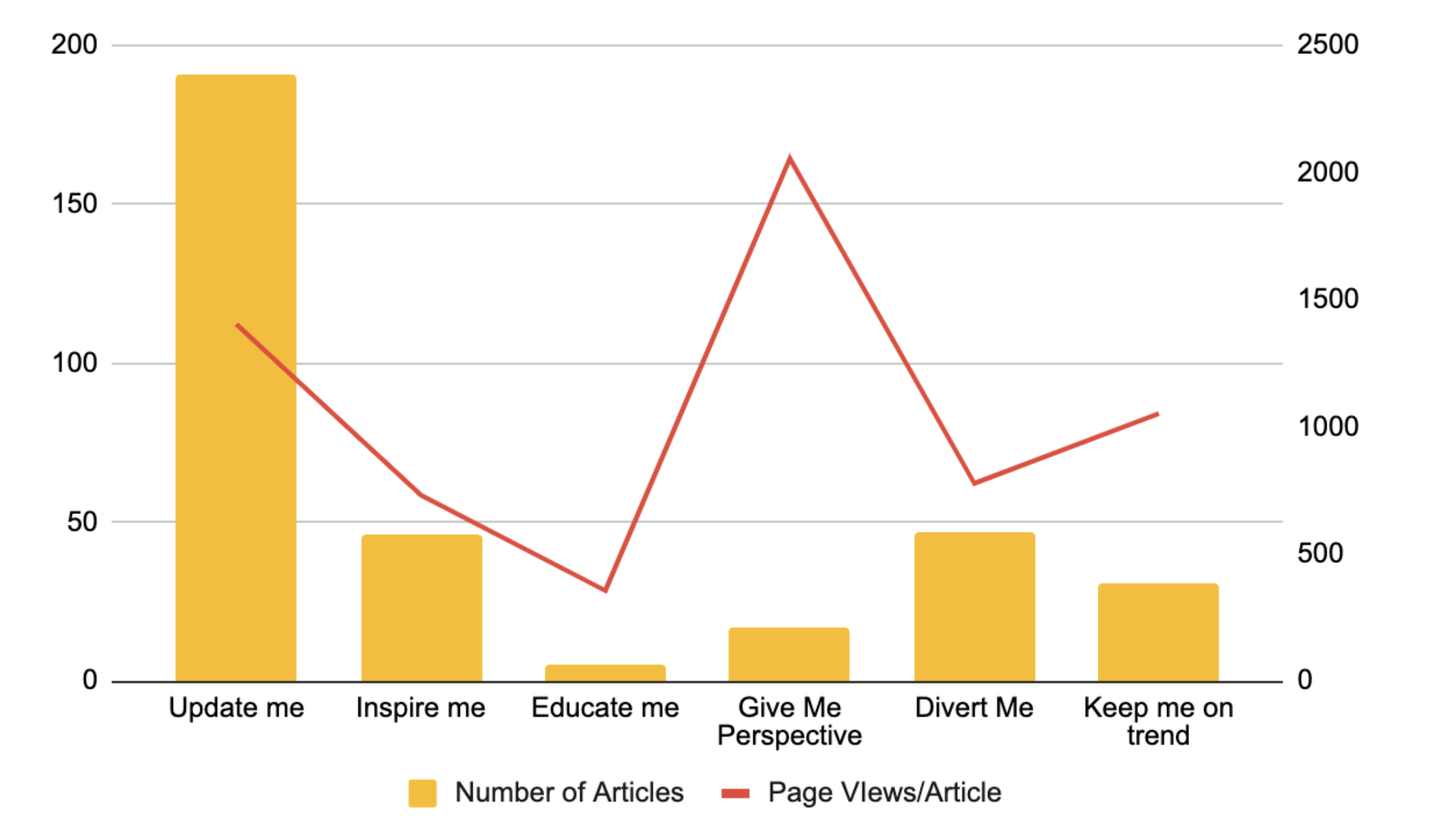




Publisher 2 found similar over-indexing towards ‘Update me’ and an opportunity to produce more ‘Give me Perspective’ articles
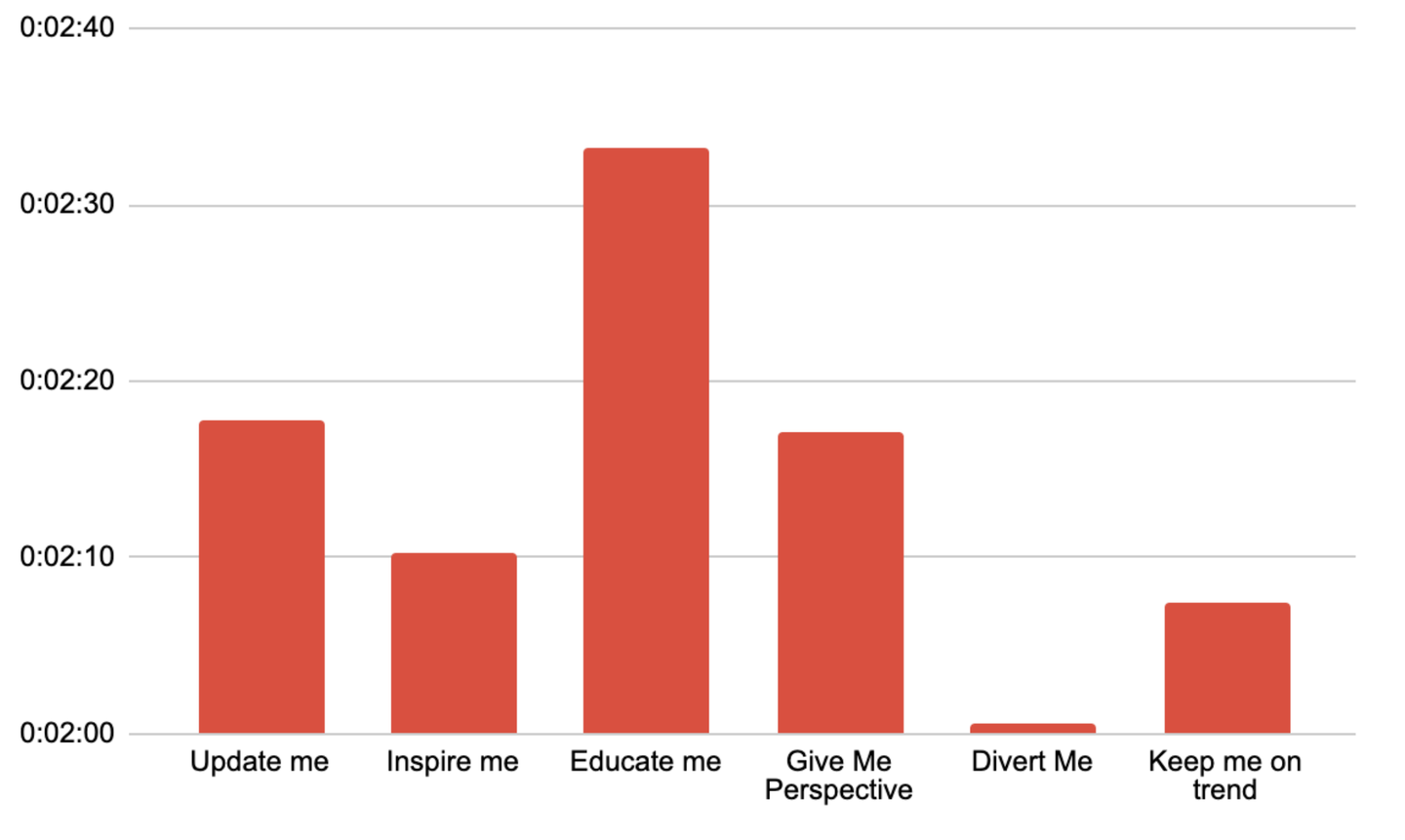




For Publisher 2, we also looked at time spent on site to gain a more holistic picture of user behaviour. We see that ‘Educate me’ articles drive the highest time spent on site
Publisher 3:
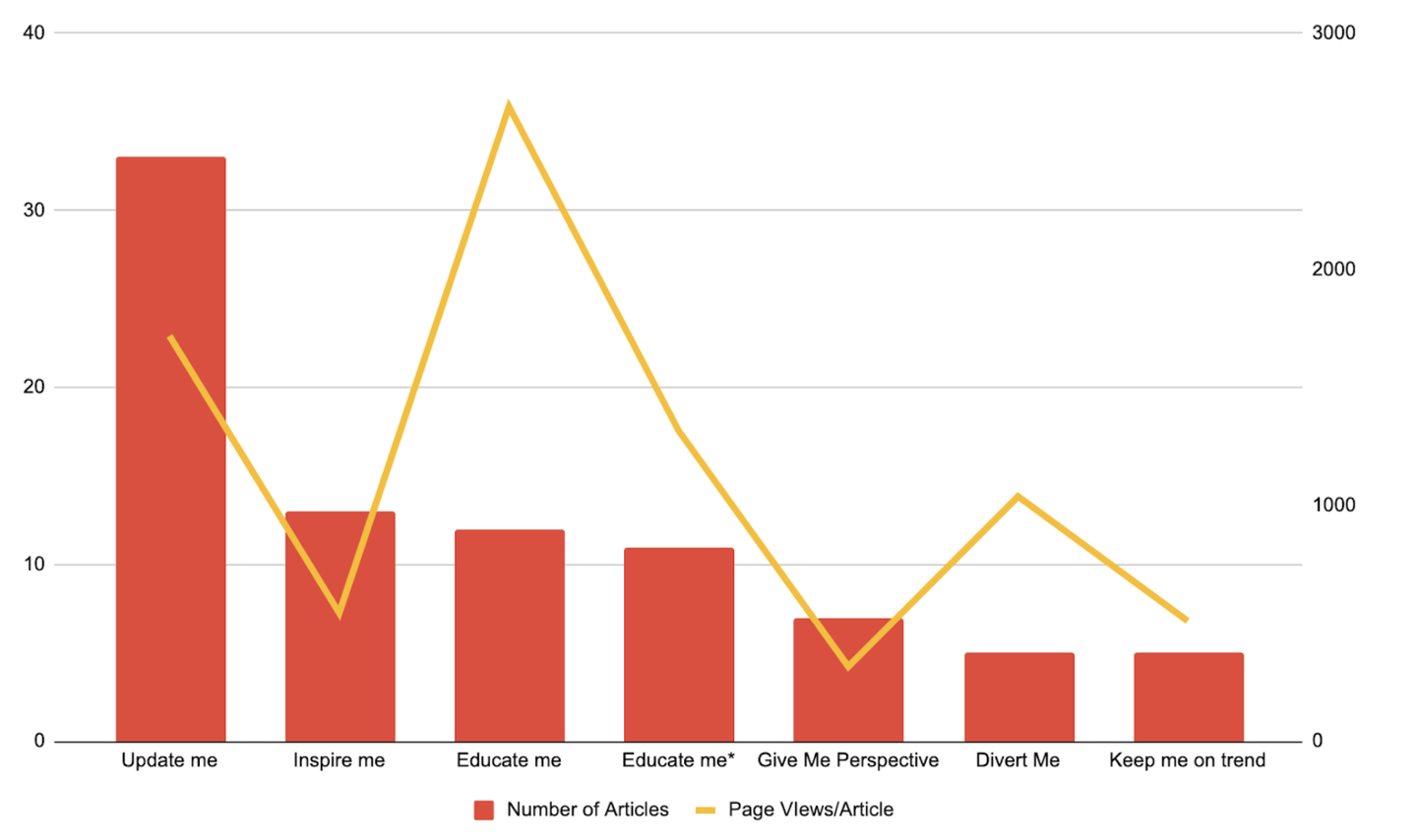




Publisher 3 over-indexed towards ‘Update me’ and under-indexed towards ‘Educate me.’ In this experiment, we also looked at how these categories drove conversion to subscribe. 96% of subscriptions were driven by non-‘Update me’ articles. Similarly, signups to ‘pay as you go’ were 97% driven by non-‘Update me’ categories
All experiments concluded in a misalignment between current content production and the ‘user needs’ that resonate most with audiences. In all cases, newspapers were overproducing breaking news and underproducing news through the prism readers wanted. An appetite for a more educational way of storytelling was prominent throughout. On a publisher-by-publisher level, we also saw a desire for more inspirational content, or content designed to divert readers or give them a new perspective.
As a result of these experiments, these publishers are re-evaluating their content strategy. Editorial teams are looking at ways to better align content output with user demand. For instance, one publisher is testing the idea of regular focus groups to re-evaluate ‘user needs’ categories and make sure the publication is listening to the voice of the reader. The experiments have started a new way of thinking that cuts across editorial sections (politics, sport, opinion) and platforms (online, app, print). Looking beyond the experiment, all three publishers decided to continue tracking ‘user needs’ and consumption on an ongoing basis.
Conducting your own experiment
Follow these four steps to conduct a similar experiment in your own newsroom:
- Work with user groups to decide the categories most relevant to them
- Nominate a member of Editorial to tag articles by category for 3 months or until sufficient content is tagged - this can be done retroactively so as not to slow down the publishing process
- Analyse the data: Ideally, consider a full range of metrics in relation to ‘user needs,’ editorial formats and topics. These include but are not limited to time on site, page views, article completion, sharing, social/search impact. If you have a subscription model, you can also look at how categories affect subscription conversion rates. Due to time constraints, our experiments focused mainly on page views and time on site.
- Re-evaluate content output by category
To sum up, ‘User Needs’ is relevant to publishers looking to maximise their resources, and publishers looking to find their Unique Selling Proposition (USP). As Dmitry Shishkin writes “Media organisations that are aware of why they exist in the market, what their USP is, and how to serve their niche audience better win, and those that don’t first drift and ultimately lose.”
Speaking to this blog, Dmitry points out: “The BBC model is broadly applicable 80% of the time, and the other 20% is normally occupied by ‘unique’ needs. Publishers should invest in proper audience research in their own niche to better understand their own audience's needs and then adapt their strategies. When analysing your performance, the most interesting things happen at the intersection of three key variables - ‘user needs,’ formats and topics. If you start measuring the impact of your stories through that triangle, you’ll optimise your output much more effectively and further strengthen your connection with audiences.”
Finally, ‘User Needs’ is of interest to us all, as consumers of news. Many of us look to journalism for more than just the ‘what’. Before learning about ‘User Needs’, I had never heard our motivations for reading news explained so well. In a world where we have social media at our fingertips, readers increasingly look to news to do more than just update.
Indeed, next time you read a story, it is worth asking yourself why you read it. When reading this blog post, for instance, was it to learn, to gain a new perspective, or perhaps, simply to be amused?




